上海版牛津英语五年级下Unit1教案
- 格式:doc
- 大小:5.00 MB
- 文档页数:8

Module Unit 1 Tidy up!教案(第一课时)教学目标:1、通过演唱Sing a song的歌曲,活跃课堂气氛,让学生感知本单元的核心句型。
2、通过Listen and sing中有关整理房间的对话,帮助学生掌握本单元的核心句型。
3、通过look and learn栏目,帮助学生学习日常生活用品的名称。
教学重、难点1、能掌握单词tidy, let, sock, cap, yours, mine, tidy up2、会运用句型Are they yours?及回答No, the y aren’t.教学方法:任务教学法、情景教学法。
(第二课时)教学目标:通过Think and write 的语言输出活动,帮助学生巩固新学的语言知识。
教学重、难点1、词汇: crayon, umbrella, hers, theirs2、句型: -Whose...is this/are these?-It’s/they’re…教学方法:任务教学法、情景教学法。
(第三课时)教学目标:1、帮助学生通过阅读故事《神奇的石头》抓住关键信息,了解故事大意,并完成后续练习。
2、 了解字母组合ar, ue, oo 在单词中的发音。
3、 通过学习任务(task),帮助学生巩固和综合运用本单元所学的知识和技能,描述物品的归属和应摆放的位置。
教学重、难点1、 语音:ar(car), ue(blue), oo(school)2、 词汇:(be) full of, a few 。
教学方法:情景教学法。
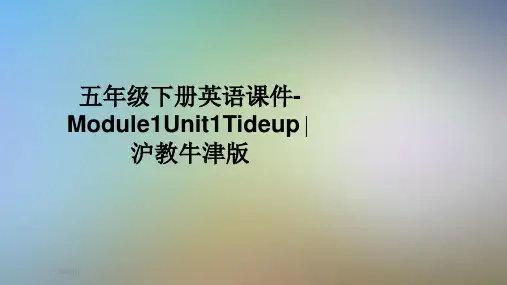
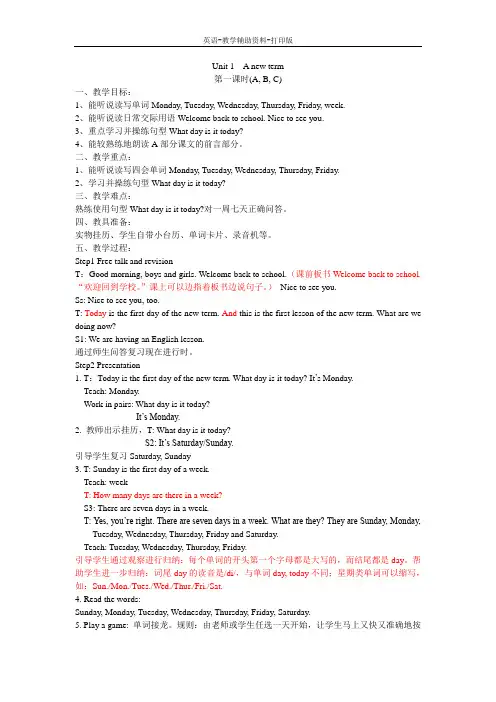
Unit 1 A new term第一课时(A, B, C)一、教学目标:1、能听说读写单词Monday, Tuesday, Wednesday, Thursday, Friday, week.2、能听说读日常交际用语Welcome back to school. Nice to see you.3、重点学习并操练句型What day is it today?4、能较熟练地朗读A部分课文的前言部分。
二、教学重点:1、能听说读写四会单词Monday, Tuesday, Wednesday, Thursday, Friday.2、学习并操练句型What day is it today?三、教学难点:熟练使用句型What day is it today?对一周七天正确问答。
四、教具准备:实物挂历、学生自带小台历、单词卡片、录音机等。
五、教学过程:Step1 Free talk and revisionT:Good morning, boys and girls. Welcome back to school.(课前板书Welcome back to school.“欢迎回到学校。
”课上可以边指着板书边说句子。
)Nice to see you.Ss: Nice to see you, too.T: Today is the first day of the new term. And this is the first lesson of the new term. What are we doing now?S1: We are having an English lesson.通过师生问答复习现在进行时。
Step2 Presentation1. T:Today is the first day of the new term. What day is it today? It’s Monday.Teach: Monday.Work in pairs: What day is it today?It’s Monday.2. 教师出示挂历,T: What day is it today?S2: It’s Saturday/Sunday.引导学生复习Saturday, Sunday3. T: Sunday is the first day of a week.Teach: weekT: How many days are there in a week?S3: There are seven days in a week.T: Yes, you’re right. There are seven days in a week. What are they? They are Sunday, Monday, Tuesday, Wednesday, Thursday, Friday and Saturday.Teach: Tuesday, Wednesday, Thursday, Friday.引导学生通过观察进行归纳:每个单词的开头第一个字母都是大写的,而结尾都是day。
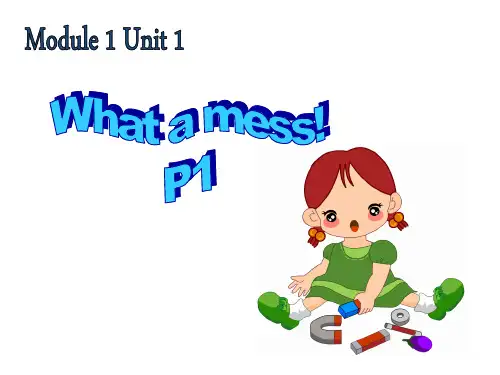
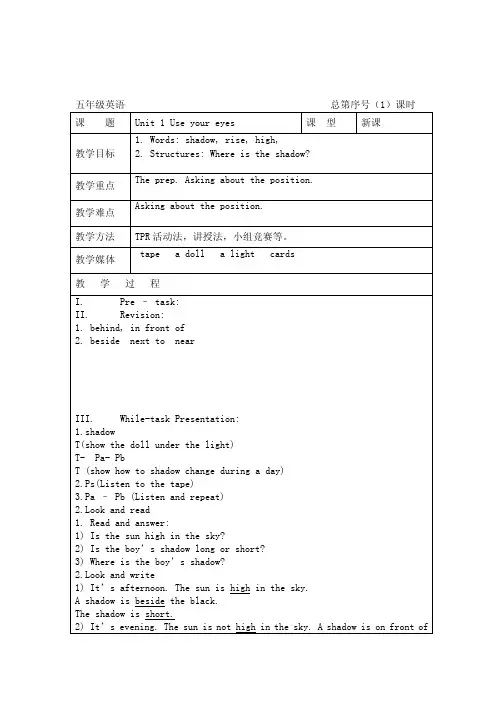
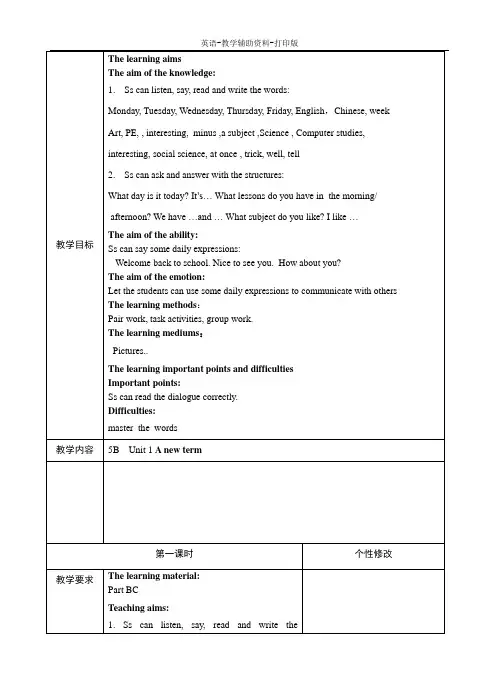
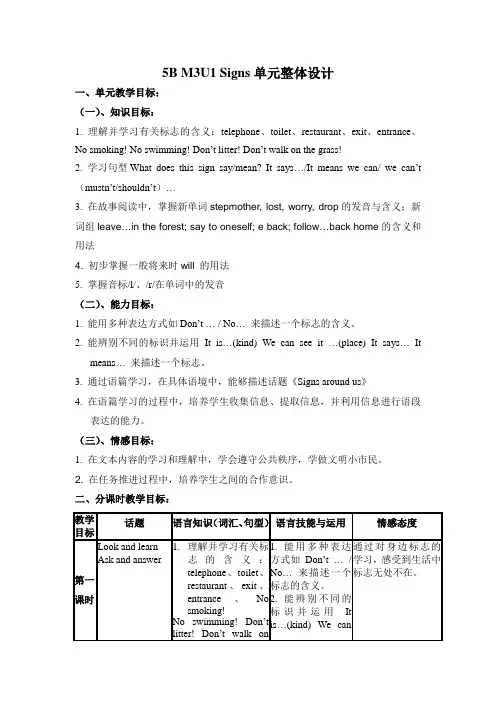
5B M3U1 Signs单元整体设计一、单元教学目标:(一)、知识目标:1. 理解并学习有关标志的含义:telephone、toilet、restaurant、exit、entrance、No smoking! No swimming! Don’t litter! Don’t walk on the grass!2. 学习句型What does this sign say/mean? It says…/It means we can/ we can’t (mustn’t/shouldn’t)…3. 在故事阅读中,掌握新单词stepmother, lost, worry, drop的发音与含义;新词组leave…in the forest; say to oneself; e back; follow…back home的含义和用法4. 初步掌握一般将来时will 的用法5. 掌握音标/l/、/r/在单词中的发音(二)、能力目标:1. 能用多种表达方式如Don’t … / No…来描述一个标志的含义。
2. 能辨别不同的标识并运用It is…(kind) We can see it …(place) It says…Itmeans…来描述一个标志。
3. 通过语篇学习,在具体语境中,能够描述话题《Signs around us》4. 在语篇学习的过程中,培养学生收集信息、提取信息,并利用信息进行语段表达的能力。
(三)、情感目标:1. 在文本内容的学习和理解中,学会遵守公共秩序,学做文明小市民。
2. 在任务推进过程中,培养学生之间的合作意识。
二、分课时教学目标:1、文本(1) 主题文本:In our life, we can see signs here and there. They are very useful. There are two kinds of signs around us. They are warning signs and information signs.Some signs tell us what we can’t do. They are warning signs. Look at the sign. It is a warning sign. We can see it beside the pond. It says ‘ No swimming!’ It means we can’t swim here.Some signs tell us what we can do and where we can go. They are information signs. Look at that sign. It is an information sign. We can see it in the park. It says ‘telephone’. It means we can use the telephone here. When we look for the telephone,we can follow the sign.Signs are our friends. It is very important for us to follow the signs. Please follow the signs and make our city better!(2) 辅助文本:1. Little sign:Hello! I am a little sign. In your life, you can see me here and there.My name is warning sign. I always say ‘Be careful!’I can tell you what you can’t do.This is my friend. He’s very useful. We call him information sign. He can tell you what you can do and where you can go .If you follow us, the city will be better!2. Chant:Can we, can we, can we swim /in the pond?We can’t, we can’t ,We can’t swim in the pond.Can we, can we, can we swim/ in the pond?Don’t, don’t ,Don’t swim in the pond!Can we, can we, can we swim in the pond?No ! No!No swimming in the pond.(3) 语用文本:Look at the sign.It is a/an _______. (kind)We can see it in the _______ (place).It says ‘________’. (things)It means ____________. (meaning)2、教案。
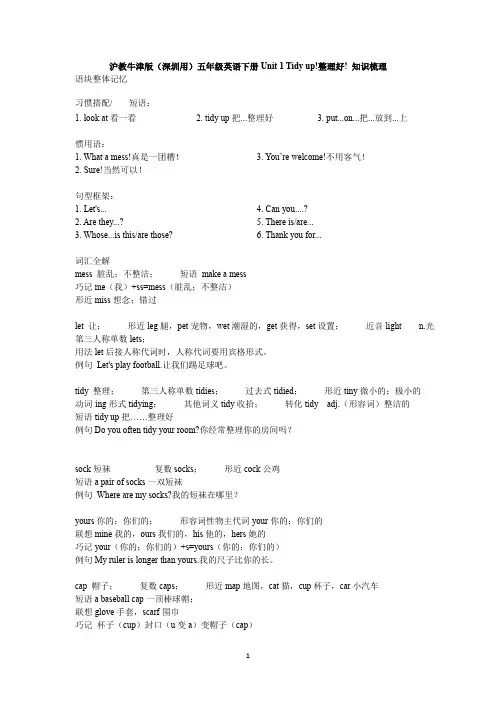
沪教牛津版(深圳用)五年级英语下册Unit 1 Tidy up!整理好! 知识梳理语块整体记忆习惯搭配/短语:1. look at看一看2. tidy up把...整理好3. put...on...把...放到...上惯用语:1. What a mess!真是一团糟!2. Sure!当然可以!3. You’re welcome!不用客气!句型框架:1. Let's...2. Are they...?3. Whose...is this/are those?4. Can you....?5. There is/are...6. Thank you for...词汇全解mess 脏乱;不整洁;短语make a mess巧记me(我)+ss=mess(脏乱;不整洁)形近miss想念;错过let 让;形近leg腿,pet宠物,wet潮湿的,get获得,set设置;近音light n.光第三人称单数lets;用法let后接人称代词时,人称代词要用宾格形式。
例句Let's play football.让我们踢足球吧。
tidy 整理;第三人称单数tidies;过去式tidied;形近tiny微小的;极小的动词-ing形式tidying;其他词义tidy收拾;转化tidy adj.(形容词)整洁的短语tidy up把……整理好例句Do you often tidy your room?你经常整理你的房间吗?sock短袜复数socks;形近cock公鸡短语a pair of socks一双短袜例句Where are my socks?我的短袜在哪里?yours你的;你们的;形容词性物主代词your你的;你们的联想mine我的,ours我们的,his他的,hers她的巧记your(你的;你们的)+s=yours(你的;你们的)例句My ruler is longer than yours.我的尺子比你的长。
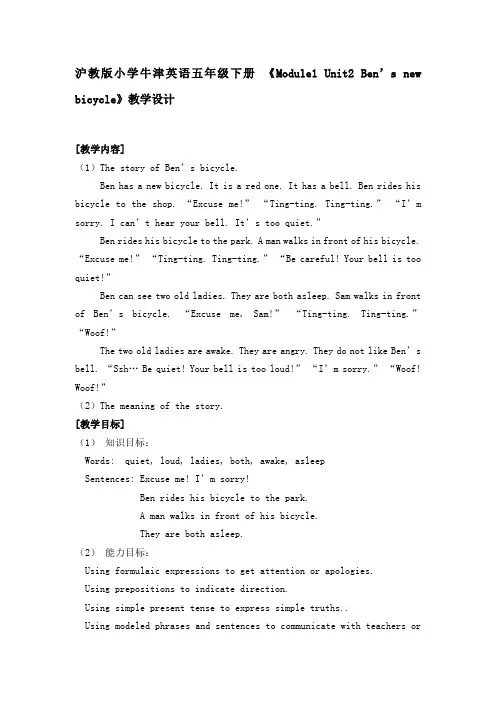
沪教版小学牛津英语五年级下册《Module1 Unit2 Ben’s new bicycle》教学设计[教学内容](1)The story of Ben’s bicycle.Ben has a new bicycle. It is a red one. It has a bell. Ben rides his bicycle to the shop. “Excuse me!”“Ting-ting. Ting-ting.”“I’m sorry. I can’t hear your bell. It’s too quiet.”Ben rides his bicycle to the park. A man walks in front of his bicycle. “Excuse me!”“Ting-ting. Ting-ting.”“Be careful! Your bell is too quiet!”Ben can see two old ladies. They are both asleep. Sam walks in front of Ben’s bicycle. “Excuse me, Sam!”“Ting-ting. Ting-ting.”“Woof!”The two old ladies are awake. They are angry. They do not like Ben’s bell. “Ssh…Be quiet! Your bell is too loud!”“I’m sorry.”“Woof! Woof!”(2)The meaning of the story.[教学目标](1)知识目标:Words: quiet, loud, ladies, both, awake, asleepSentences: Excuse me! I’m sorry!Ben rides his bicycle to the park.A man walks in front of his bicycle.They are both asleep.(2)能力目标:Using formulaic expressions to get attention or apologies.Using prepositions to indicate direction.Using simple present tense to express simple truths..Using modeled phrases and sentences to communicate with teachers orother learners.(3)情感目标:Inspire the students’ interest.Identify main ideas from a text with teacher support.[教学重难点](1)To master the simple present tense.(2)To talk about or retell the story by themselves.(3)To use these words and sentences in activities and daily life. [课堂实录]Step 1 Warm up(1)Listen to a song together: Page 10Sing the song together.T: Can you ride a bicycle?Who has got a bicycle?第一位学生:What color is your bicycle?Is it big or small?Does it have a bell?Is it loud or quiet?Do you like your bicycle?Can you ride your bicycle fast?学生依次回答完问题后,可以根据最后一个问题回答情况补充:T:You are super. But be careful. Sometimes it’s dangerous. OK? 第二位学生:Have you got a bicycle?Describe your bicycle, can you?学生描述完后教师根据描述提出问题:T:What color is his bicycle?Is it big or small?Does it have a bell?Is it loud or quiet?Does he like his bicycle?Can he ride his bicycle fast?……第三位学生:What about you?Can you describe your bicycle?学生描述完后T:Do you have any questions about his/her bicycle?让学生自己提出问题和回答问题。
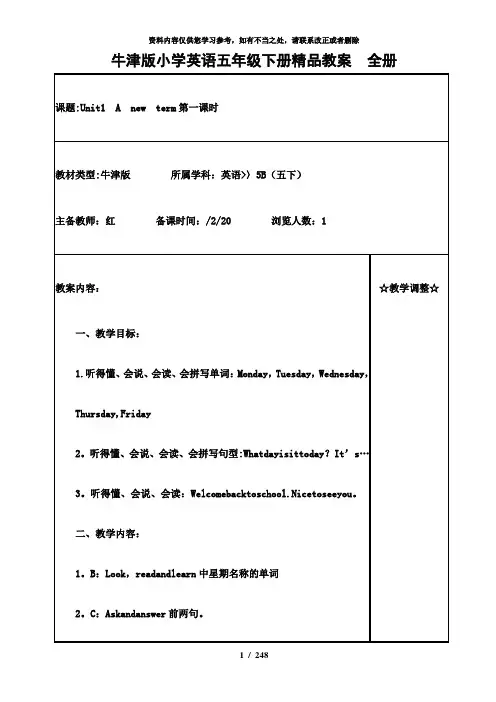
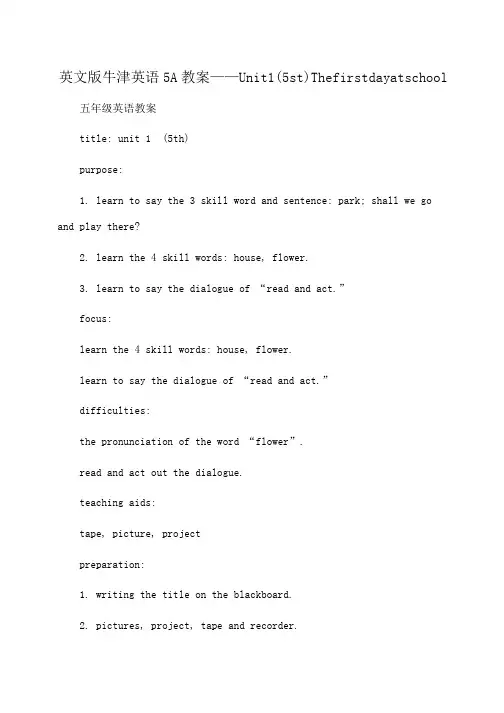
英文版牛津英语5A教案——Unit1(5st)Thefirstdayatschool 五年级英语教案title: unit 1 (5th)purpose:1. learn to say the 3 skill word and sentence: park; shall we go and play there?2. learn the 4 skill words: house, flower.3. learn to say the dialogue of “read and act.”focus:learn the 4 skill words: house, flower.learn to say the dialogue of “read and act.”difficulties:the pronunciation of the word “flower”.read and act out the dialogue.teaching aids:tape, picture, projectpreparation:1. writing the title on the blackboard.2. pictures, project, tape and recorder.writing on the blackboard:unit 1 the first day at schoolyes,……flowers….is there a park near your house?are there any swings?shall we go and play there?summary of this lesson:通过谈论公园里的花草树木及设施,再次练习is there a/an …? are there any …?等句型。
对话中出现的shall we …? good idea.在4b中以学过,学生不难理解。